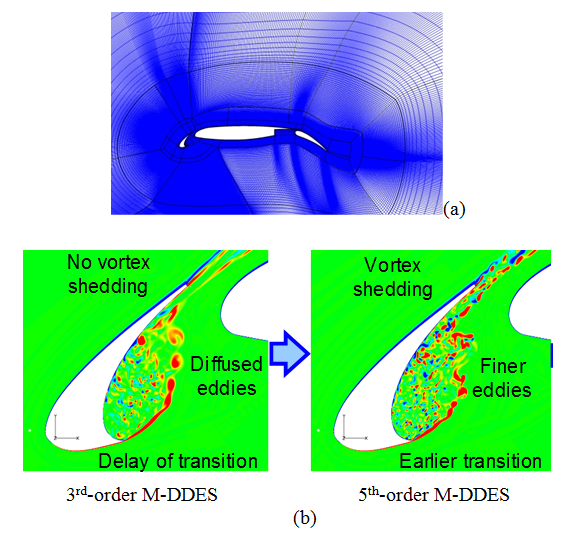Environment Conscious Aircraft Systems Research in Eco-wing Technology:Airframe-Engine Noise Reduction Technology
JAXA Supercomputer System Annual Report April 2016-March 2017
Report Number: R16E0002
- Responsible Representative: Yoshikazu Makino(Next Generation Aeronautical Innovation Hub Center, Aeronautical Technology Directorate)
- Contact Information: Dongyoun Kwak(kwak.dongyoun@jaxa.jp)
- Members: Takehisa Takaishi, Mitsuhiro Murayama, Yasushi Ito, Ryotaro Sakai, Tohru Hirai, Kentaro Tanaka, Kazuhisa Amemiya, Gen Nakano, Tomoaki Ikeda, Fumitake Kuroda, Keisuke Ohira, Dongyoun Kwak, Yosuke Matsumura
- Subject Category: Aviation(Aircraft,Body sound,Aircraft engine)
Abstract
Innovative drag reduction technologies are investigated to reduce the fuel consumption for a conventional aircraft configuration. Aircraft noise prediction technologies and the conceptual design technologies are also developed for future aircraft which achieve low noise and high efficiency.
Goal
Please refer ‘Eco-wing technology | ECAT – Environment-Conscious Aircraft Technology Program | Aeronautical Technology Directorate‘.
Objective
Please refer ‘Eco-wing technology | ECAT – Environment-Conscious Aircraft Technology Program | Aeronautical Technology Directorate‘.
References and Links
Please refer ‘Eco-wing technology | ECAT – Environment-Conscious Aircraft Technology Program | Aeronautical Technology Directorate‘.
Use of the Supercomputer
The JSS2 is used to develop the airframe, engine, and interference noise prediction tools that have high or middle fidelities for applicable to MDO design with high fidelity CFD and FEM analysis.
Necessity of the Supercomputer
The airframe-engine installation and/or shielding effects are one of important key issues for the future aircraft. The accuracy of current low fidelity analysis for the airframe, engine, and interference noise prediction is not good enough for application to MDO design with high fidelity CFD and FEM analysis toward the future low-noise aircrafts. The JSS2 is required for development of high or middle fidelity noise prediction tools for competitiveness in technology.
Achievements of the Year
– Through benchmarking problems in CFD workshop, higher technical maturity level of airframe noise prediction, in-house computational grid generators and flow solvers was achieved.
– New features of higher-order spatial accuracy in UPACS, JAXA’s multi-block CFD package, were evaluated for the application of large-scale airframe noise benchmarking problem (Fig.1). The improvements in the accuracy and efficiency were demonstrated through the large-scale computations. The computational time was shortened from 50 days to 20 days.

Fig.1 : Comparison of the computational results using 3rd-order and 5th-order schemes. (a) Computational grid, (b) Instantaneous span wise vorticity contours around slat.
Publications
Presentations
1) Ito, Y., Murayama., M., Yamamoto., and K., Tanaka, K., ‘TAS Code Results for the Sixth Drag Prediction Workshop,’ 6th AIAA CFD Drag Prediction Workshop, June 2016.
2) Murayama., M., Ikeda, T., Yamamoto, K., Amemiya, K., Tanaka, K., and Hirai, T., ‘BANC-IV Category 7 Slat Cove Noise: 30P30N-Modified Slat Configuration – JAXA’s Computational Result -,’ 4th AIAA Workshop on Benchmark Problems for Airframe Noise Computations (BANC-IV), June 2016.
3) Ikeda, T., Amemiya, K., and Yamamoto, K., ‘On the Implementation of Higher-order Spatial Discretization Schemes into JAXA’s UPACS,’ APISAT 2016, October 2016.
4) Ito, Y., Murayama, M., Hashimoto, A., Ishida, T., Yamamoto, K., Aoyama, T., Tanaka, K., Hayashi, K., Ueshima, K., Nagata, T., Ueno, Y., and Ochi, S., ‘TAS Code, FaSTAR and Cflow Results for the Sixth Drag Prediction Workshop,’ AIAA 2017-0959, January 2017.
Computational Information
- Parallelization Methods: Process Parallelization, Thread Parallelization, Hybrid Parallelization, Serial
- Process Parallelization Methods: MPI
- Thread Parallelization Methods: OpenMP , Automatic Parallelization
- Number of Processes: 15-300
- Number of Threads per Process: 4-32
- Number of Nodes Used: 1-32
- Elapsed Time per Case (Hours): 0.5-5
- Number of Cases: 3000
Resources Used
Total Amount of Virtual Cost(Yen): 37,622,568
Breakdown List by Resources
| System Name | Amount of Core Time(core x hours) | Virtual Cost(Yen) |
|---|---|---|
| SORA-MA | 22,676,318.01 | 37,019,225 |
| SORA-PP | 6,507.83 | 55,563 |
| SORA-LM | 0.00 | 0 |
| SORA-TPP | 0.00 | 0 |
| File System Name | Storage assigned(GiB) | Virtual Cost(Yen) |
|---|---|---|
| /home | 115.43 | 1,088 |
| /data | 17,886.53 | 168,724 |
| /ltmp | 8,482.15 | 80,012 |
| Archiving System Name | Storage used(TiB) | Virtual Cost(Yen) |
|---|---|---|
| J-SPACE | 96.51 | 297,954 |
Note: Virtual Cost=amount of cost, using the unit price list of JAXA Facility Utilization program(2016)
JAXA Supercomputer System Annual Report April 2016-March 2017


